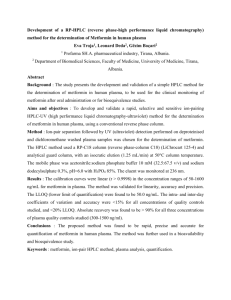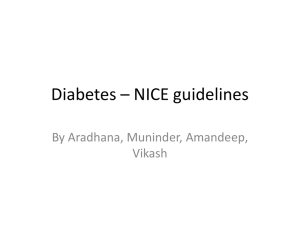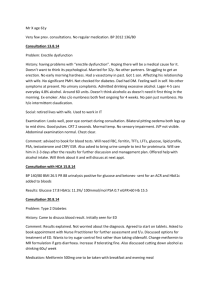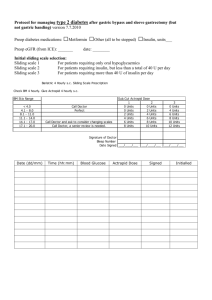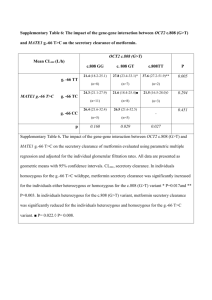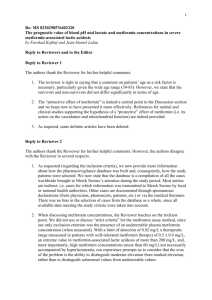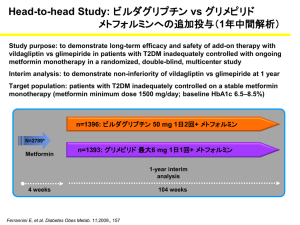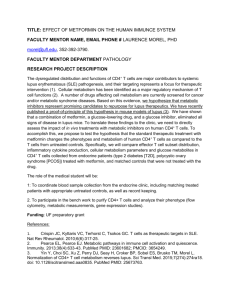Manipulation of the Energetic Metabolism
advertisement
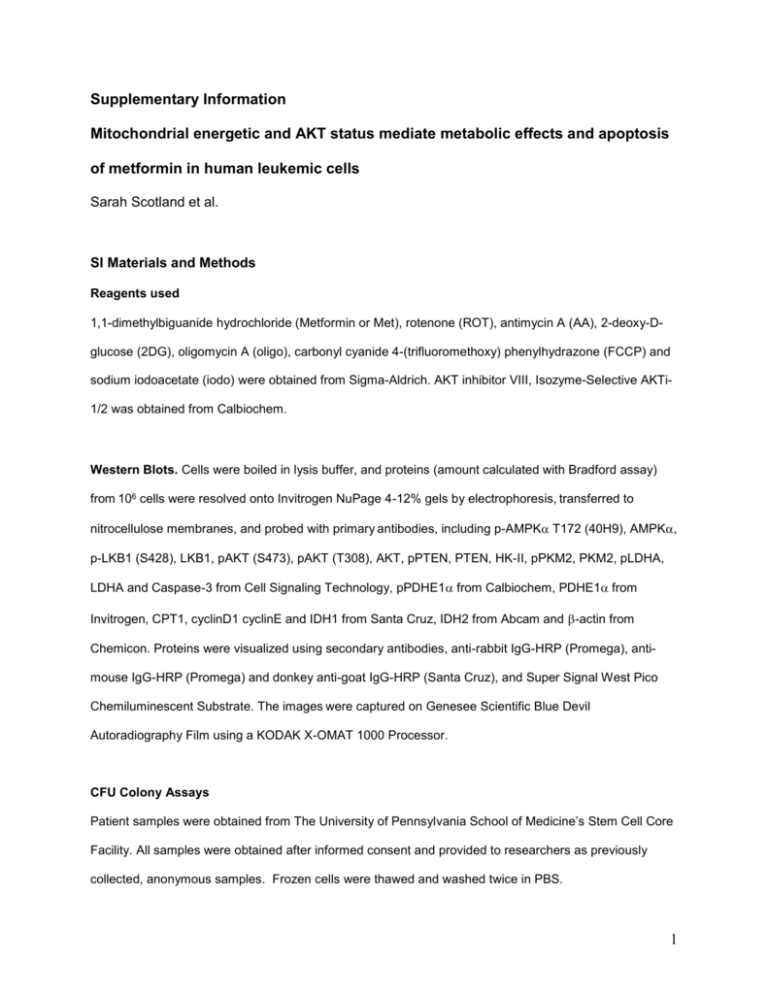
Supplementary Information Mitochondrial energetic and AKT status mediate metabolic effects and apoptosis of metformin in human leukemic cells Sarah Scotland et al. SI Materials and Methods Reagents used 1,1-dimethylbiguanide hydrochloride (Metformin or Met), rotenone (ROT), antimycin A (AA), 2-deoxy-Dglucose (2DG), oligomycin A (oligo), carbonyl cyanide 4-(trifluoromethoxy) phenylhydrazone (FCCP) and sodium iodoacetate (iodo) were obtained from Sigma-Aldrich. AKT inhibitor VIII, Isozyme-Selective AKTi1/2 was obtained from Calbiochem. Western Blots. Cells were boiled in lysis buffer, and proteins (amount calculated with Bradford assay) from 106 cells were resolved onto Invitrogen NuPage 4-12% gels by electrophoresis, transferred to nitrocellulose membranes, and probed with primary antibodies, including p-AMPK T172 (40H9), AMPK, p-LKB1 (S428), LKB1, pAKT (S473), pAKT (T308), AKT, pPTEN, PTEN, HK-II, pPKM2, PKM2, pLDHA, LDHA and Caspase-3 from Cell Signaling Technology, pPDHE1 from Calbiochem, PDHE1 from Invitrogen, CPT1, cyclinD1 cyclinE and IDH1 from Santa Cruz, IDH2 from Abcam and -actin from Chemicon. Proteins were visualized using secondary antibodies, anti-rabbit IgG-HRP (Promega), antimouse IgG-HRP (Promega) and donkey anti-goat IgG-HRP (Santa Cruz), and Super Signal West Pico Chemiluminescent Substrate. The images were captured on Genesee Scientific Blue Devil Autoradiography Film using a KODAK X-OMAT 1000 Processor. CFU Colony Assays Patient samples were obtained from The University of Pennsylvania School of Medicine’s Stem Cell Core Facility. All samples were obtained after informed consent and provided to researchers as previously collected, anonymous samples. Frozen cells were thawed and washed twice in PBS. 1 Viable cells were resuspended at 100,000 cells/mL in PBS and 400 uL were added to 3.6mL Human Methylcellulose Enriched Media from R&D Systems. 1mL of the methylcellulose and cell combination were replated in NUNC suspension dishes for a total of 10,000 cells per dish. Treatments were done in triplicate with metformin dissolved in PBS (or PBS alone for control) added to the plated dish. Dishes were incubated at 37C with 5% CO2 for 14 days, after which colonies were counted. The cell line CFU colony assays were performed using the same protocol listed for patient samples except only 1000 cells per 1 mL of methylcellulose were plated. The methylcellulose used was 80% Methylcellulose (MethoCult H4320) and 20% Iscove’s Modified Dulbecco’s Medium (IMDM) from Invitrogen. Additionally, the colonies were counted after 5-7 days. Cell Cycle by Flow Cytometry Cell cycle analysis by flow cytometry was performed using staining for Ki67 (FITC mouse anti-human Ki67 Set from BD Pharmingen) and PI (propidium iodide from Sigma-Aldrich). In summary, 500,000 cells were collected, washed with PBS, centrifuged and resuspended in 1 mL PBS. Cells were fixed with 2 mL 100% ethanol and stored overnight at -20C. The next day, cells were centrifuged, washed in PBS+BSA (1%), centrifuged again and resuspended in 1 mL 0.25% TritonX100 for permeabilization. Cells were left for 10 minutes at 4C. Following this incubation, cells were washed, centrifuged and then treated with 18 uL of Ki67 in 100uL PBS+BSA (1%). Cells were left for 30 minutes at room temperature and in the dark. Cells were then washed, centrifuged and resuspended with 300 uL PBS-RNase (1ug/mL) and 3 uL PI. Cells were incubated for 2 hours at room temperature and in the dark. Cells were then analyzed using a FACSCalibur flow cytometer with CELLQuest-Pro software. Electron Transport Chain Complex I Activity. Five million cells were used to measure enzymatic activities. Rotenone sensitive NADH ubiquinone oxidoreductase activity (respiratory complex I activity) was determined as described elsewhere(1). Normalization was done by citrate synthase (CS) activity, which is a mitochondrial matrix enzyme, as described elsewhere(2). 2 Measurement of Oxygen Consumption in Cultured Cells Cell lines were incubated in medium either in conditions of untreated, metformin, antimycin A for 24hrs. Following incubation, four million cells were resuspended in 155 uL of fresh medium, matching whichever media the cells were grown in, and analyzed in a water-jacketed, air-tight chamber with a Strathkelvin Clark oxygen electrode. Measurements were taken at 37C with constant stirring. The specific oxygen consumptions described in Figure S1 represent the following measurement: Basal is the basal rate; ATP turnover is the basal oligomycin A-insensitive rate (i.e. oligomycin sensitive); H+ Leak is oligomycin A minus insensitive rate; maximal is the uncoupler rate; spare respiratory capacity is the uncouplerstimulated minus basal rate. ATP Analysis ATP was measured using the Promego Cell Titer Glo kit and protocol. In summary, following treatment, 50,000 cells were resuspended in 80uL and distributed in a 96 well plate. Cells were then treated in replicates of five with control (PBS), oligomycin A, FCCP or sodium iodoacetate both alone or in combination with oligomycin A or FCCP. Following a 1-hour incubation, 100uL of cell titer glo reaction mix were added to each well for a final volume of 200uL. Plates were then analyzed for luminescence with a Perkin Elmer Luminoscan. By comparing the different conditions, global ATP and percentages of both glycolytic and mitochondrial ATP were determined. Lactate Production Lactate production for all other lactate figures was determined using the Abnova Lactate Assay Kit and subsequent protocol. In summary, supernatants were collected following 24-hour treatment and frozen at -80C. For testing, samples were thawed, mixed, centrifuged and diluted in the assay buffer. 50 uL of sample were added to each well followed by 50 uL of reaction mix, which contained 47 uL lactate asay buffer, 2uL probe and 2 uL enzyme mix. Samples were mixed. The plate was incubated for 30 minutes at room temperature and the absorbance was read at 570nM. The final lactic acid concentration in nmol/well was determined by comparing absorbance values to a standard curve prepared with the sample conditions. 3 Flux Analysis. Macro-kinetics analysis of MOLM14 and U937 cells in MEM (5.6mM) + 10% FBS after 24hrs incubation with untreated, 10 mM metformin or 10 uM antimycin A. The concentration of glucose, glutamine and lactate in the medium were taken from the Nova Biomedial Bioprofile Flex Analyser data previously described. The oxygen consumption data was taken from the oxygen consumption assay previously described. The uptake rates (qs) were calculated using the following equation, S(24) = S(0) – qs/*X(0)*EXP(*24); where S(24) and S(0) are the substrate concentrations at 24h and 0h respectively, is the growth rate in h-1, and X(0) is the mass of cell at 0h calculated from cell density measurement (0.5E10 cells per mL) multiplied by the cell dry weight conversion (1 cell = 400 pg(CDW)). Consumption rate (ps) were calculated using the equation, S(24) = S(0) + ps/*X(0)*EXP(*24). Calculations were done using a growth rate of 0.045 h-1 (calculated from proliferation measurement) or assuming that cells treated with metformin or antimycin had no cell growth. In this last cases the growth components were removed from the equations leading to use the following form S(24) = S(0) – qs*X(0)*24 Liquid chromatography coupled to electrospray-LTQ-Orbitrap mass spectrometry with data processing and multivariate statistical analysis. Method 1 – Intracellular metabolites were analyzed as described previously(3). Briefly, analysis was performed by high performance anion exchange chromatography (Dionex ICS 2000 system, Sunnyvale, USA) coupled to a triple quadrupole QTrap 4000 (Applied Biosystems, Foster City, USA) mass spectrometer. All samples were analyzed in the negative mode giving [M-H]- ions, which were monitored in the multiple reaction monitoring (MRM) mode. The injection volume was 15 µL. To get highly accurate quantification, the Isotope-Dilution Mass Spectrometry (IDMS) method was applied(4). Method 2 – A total of 10 μL of samples was injected and separated on a 2.1 × 150-mm Hypersil gold C18 1.9-μm column (Thermo Electron) equipped with an on-line prefilter (Interchim). The flow rate was 0.5 mL/min with mobile phases A (100% water) and B (100% acetonitrile), both containing 0.1% formic acid. The gradient consisted of an isocratic step of 2 minutes at 100% phase A, followed by a linear gradient from 0% to 100% of phase B for the next 13 minutes, before returning to 100% A for 4 minutes. Mass 4 spectrometric detection was performed using an LTQ-Orbitrap hybrid mass spectrometer (Thermo Electron) fitted with an electrospray source operated in the positive and negative ion modes. The detection was achieved from 50 to 1000 u at the maximum resolving power of 30000 (expressed as full width at half maximum for an ion at 400 U). The mass spectrometer was operated with capillary voltage at 4 kV and capillary temperature at 275°C. The sheath gas pressure and the auxiliary gas pressure were set, respectively, at 45 and 10 arbitrary units with nitrogen gas. Samples were randomly analyzed together by ultra-high performance liquid chromatography coupled to mass spectrometry (UHPLC/MS), and a quality control sample was injected every 10 RBC samples to check the performance of the analytical system in terms of retention times, accurate mass measurements, and signal intensities. Collision-induced dissociation spectra were acquired using the data-dependent scanning function for identification purpose. The scan event cycle composed a full scan mass spectrum at a resolution power of 30000 and one or 2 data-dependent (MS2and MS3) events acquired with a resolution set to 7500. Microscan count was set to unity, and a repeat count for dynamic exclusion was set to 3. MSn acquisition parameters were an isolation width of 1 u, normalized collision energy ranging from 15% to 45%, and an activation time of 30 ms. Our data processing for method 2 included 2 main steps: (1) Automatic peak detection. Raw data were analyzed using the XCMS software Version 1.14.1 running under R Version 2.8.1,19 (http://www.bioconductor.org/packages/bioc/html/xcms.html). The UHPLC/MS data were peakdetected and noise-reduced in both the LC and MS domains to exclude peaks related to noise. The resulting datasets consisted of a single matrix containing features with m/z-retention time pair as an identifier and their intensity values for each sample. (2) Annotation of the datasets. The datasets resulting from the XCMS process were then annotated using tools developed in-house. The resulting data from the XCMS process were first mean-centered and scaled either to unit variance or to Pareto variance, then introduced into SIMCA-P11 (Umetrics) for multivariate analyses by unsupervised principal component analysis (PCA) or by supervised projection to latent structure-discriminant analysis (PLS-DA). The PLSDA models were validated using the cross-validation function of SIMCA-P11 and by permutation tests (k = 100). In the 2 analyses, the first principal component t[1] accounts for as much of the variability in the data as possible, and the second t[2] and third t[3] components account for as much of the remaining variability. 5 Metabolic Gene Expression. Cells treated for 24hrs were centrifuged and stored as frozen cell pellets in a freezer at -80C. RNA was extracted from frozen cell pellets using the procedure described in the Qiagen RNeasy Mini Kit. RNA concentrations were then calculated using the NanoDrop ND-1000 Spectrophotometer and computer program. Following concentration analysis, we used the PTC-100 Programmable Thermal Controller to produce cDNA with the iScript cDNA Synthesis Kit (Bio-Rad) following the PTC iScript program guide. Final gene expression was determined using a 7500 Real Time PCR System (AB Applied Biosystems). Thermodynamic analysis. To determine how far from thermodynamic equilibrium the metabolic reactions in our cells operate, we used an equation previously described(5): ΔG = ΔGKeq − ΔGMAR. Herein, ΔGKeq and ΔGMAR are free energies of a reaction (ΔG) at equilibrium (Keq) and at a particular mass-action ratio (MAR), respectively. Values of free energies were calculated by applying the equation ΔG = −RTlnK, where R and T are gas constant and absolute temperature (310.15 K), respectively, while K is Keq or an MAR. ΔGKeq in case of the PRPP biosynthesis was calculated from the theoretical standard free energy of formation of the compounds, and MAR was determined using the quantified metabolite pool sizes. Supplemental References 1. Gutierrez Cortes N, Pertuiset C, Dumon E, Borlin M, Hebert-Chatelain E, Pierron D, et al. Novel mitochondrial DNA mutations responsible for maternally inherited nonsyndromic hearing loss. Hum Mutat. 2012 Apr;33(4):681-9. 2. Rocher C, Taanman JW, Pierron D, Faustin B, Benard G, Rossignol R, et al. Influence of mitochondrial DNA level on cellular energy metabolism: implications for mitochondrial diseases. J Bioenerg Biomembr. 2008 Apr;40(2):59-67. 3. Bolten CJ, Kiefer P, Letisse F, Portais JC, Wittmann C. Sampling for metabolome analysis of microorganisms. Anal Chem. 2007 May 15;79(10):3843-9. 6 4. Wu L, Mashego MR, van Dam JC, Proell AM, Vinke JL, Ras C, et al. Quantitative analysis of the microbial metabolome by isotope dilution mass spectrometry using uniformly 13C-labeled cell extracts as internal standards. Anal Biochem. 2005 Jan 15;336(2):164-71. 5. Klimacek M, Krahulec S, Sauer U, Nidetzky B. Limitations in xylose-fermenting Saccharomyces cerevisiae, made evident through comprehensive metabolite profiling and thermodynamic analysis. Appl Environ Microbiol. 2010 Nov;76(22):7566-74. 7 Supplemental Figures Figure S1. Initial hypothesis. Putative multi-pathway metabolic based mechanisms of action of metformin in cancer cells. 8 9 Figure S2. Metformin blocks cell cycle in AML cells. (A). Flow cytometry analysis of cell cycle using PI and Ki67 staining of HL60, MOLM14 and U937 cells following 24 hrs and 48 hrs treatment with control or 10 mM metformin. (B) Western blot data analysis of the cells in Figure S2A for cyclinD1 and cyclinE expression, normalized to -actin. Statistics were performed with an unpaired t-test with p-values represented as *** for p<0.005, ** for p<0.01, and * for p<0.05 (# substituted for * if two instances of significance for a control). 10 Figure S3. Metformin kinetics of AMPK expression. Western blot data comparing the kinetic effect of control, 1 mM metformin, and 10 mM metformin at 1, 3, 6 and 24 hrs in MOLM14 and U937 cells. Western blots were analyzed using primary antibodies for pAMPK (T172) and AMPK, all normalized to -actin. 11 Figure S4. Specific rates of mitochondrial oxygen consumption and glutamine consumption in response to metformin. (A) The graphs represent specific oxygen consumption rates, measured as nmol/min/million cells, in HL60, MOLM14 and U937 cells in after 24hrs with control, 10 mM metformin or 10 uM antimycin A (AA). The specific oxygen consumptions described represent the following equations: Basal is the basal rate; ATP turnover is the basal minus oligomycin rate; H+ Leak is oligomycin minus insensitive rate; Maximal is the uncoupler rate; spare is the uncoupler minus basal rate. (B) Glutamine consumption (mmol/g(CDW)/h) in HL60, MOLM14 and U937 cells in after 24hrs with control, 10 mM metformin or 10 uM antimycin A. 12 Figure S5. Metabolic activity in MOLM14 versus U937. (A) Basal oxygen, glutamine and glucose consumption and lactate production measured as mmol/g(CDW)/h in MOLM14 and U937. (B) The basal percentage of glycolytic or mitochondrial ATP production in MOLM14 and U937 cells. 13 Figure S6. Metformin kinetics of ATP and lactate production. (A) Global ATP content as ratio to control in MOLM14 and U937 cells after 1, 3, 6 and 24 hrs with 0.0, 0.1, 1.0 and 10.0 mM metformin. (B) Pasteur effect induction measured as a percentage of glycolytic ATP induced by metformin in MOLM14 and U937 cells after 1, 3, 6 and 24 hrs with control or 10 mM metformin. (C) Lactate production, represented as ratio to control, of MOLM14 and U937 cells after 1, 3, 6, and 24 hrs with control or 10 mM metformin. 14 Figure S7. Additional metabolite, gene and protein expression data in response to metformin in U937 and MOLM14 cells. (A) Quantified intracellular concentrations of metabolites, calculated as ratio of 10 mM metformin to control, for MOLM14 and U937 cells after 24hrs. (B) Western blot data in MOLM14 15 and U937 cells after 24hrs incubation with control, 2 mM metformin, 10 mM metformin or 200 nM rotenone (Rot). Western blots were analyzed using primary antibodies for pPDH-E1, PDH-E1, HK-II, GAPDH, pPKM2, PKM2, pLDHA, LDHA, IDH1, IDH2, pACC, ACC and CPT1, normalized to -actin. For metabolite abbreviations: adenosine triphosphate (ATP), adenosine diphosphate (ADP), cytidine triphosphate (CTP), cytidine diphosphate (CDP), cytidine monophosphate (CMP), guanosine diphosphate (GDP), uridine triphosphate (UTP), uridine diphosphate (UDP), uridine monophosphate (UMP), nicotinamide adenine dinucleotide (NADH, NAD+). For western blot abbreviations: pyruvate dehydrogenase, E1 subunit (PDH-E1), hexokinase 2 (HK-II), glyceraldehydes 3-phosphate dehydrogenase (GAPDH), type M2 pyruvate kinase (PKM2), lactate dehydrogenase A (LDHA), isocitrate dehydrogenase 1 (IDH1), isocitrate dehydrogenase 2 (IDH2), acetyl-coA carboxylase (ACC), carnitine palmitolytransferase I (CPT1). 16 Figure S8. Basal metabolisms of U937 and MOLM14 have significant differences that correlate to cytotoxic response to metformin. Comparison of (A) metabolite levels and (B) gene expression as a ratio of U937 to MOLM14. For metabolite abbreviations, glucose -1-phosphate (G1P), glucose-6phosphate (G6P), fructose-6-phosphate (F6P), mannose-6-posphate (Man6P), fructose-1,6-bisphosphate (FBP), glyceraldehyde-3-phosphate (GLY-3P), 1,3-phosphodiglycerate (1,3-DiPG), 2/3-phosphoglycerate (2/3-PG), phosphoenolpyruvate (PEP), 6-phosphogluconate (6-PG), sedoheptulose-7-phosphate (Sed7P), ribose-1-phosphate (R1P), ribose-5-phosphate (Rib5P), ribulose-5-phosphate (Ribu5P), 17 xylulose-5-phosphate (Xylu5P), phosphoribosyl pryphosphate (PRPP), inosine monophosphate (IMP), adenosine triphosphate (ATP), adenosine diphosphate (ADP), adenosine monophosphate (AMP), cytidine triphosphate (CTP), cytidine diphosphate (CDP), cytidine monophosphate (CMP), guanosine diphosphate (GDP), guanine monophosphate (GMP), uridine triphosphate (UTP), uridine diphosphate (UDP), uridine monophosphate (UMP), nicotinamide adenine dinucleotide (NADH, NAD+), alphaketoglutarate (-KG). For gene expression abbreviations, glucose transporter 1 (Glut1), TP53 (Tumor Protein 53)-induced glycolysis and apoptosis regulator (Tigar), 6-phosphofructo-2-kinase/fructose-2,6biphosphatase 4 (Pfkfb4), glyceraldehyde-3-phosphate dehydrogenase (Gapdh), enolase 2 (Eno2), glucose-6-phosphate dehydrogenase (G6pd), transketolase (Tkt), solute carrier family 7 (amino acid transporter light chain, L system), member 5 (Slc7a5), glutamate oxaloacetate transaminase 1 (Got1), glutaminase 1 (Gls1), glutaminase 2 (Gls2), isocitrate dehydrogenase 1 (Idh1), phosphoenolpyruvate carboxykinase 2 (Pck2), ATP citrate lyase (Acly). 18 Figure S9. Thermodynamic status of U937 and MOLM14. (A) Thermodynamic states, measured as ∆∆G in KJ/mol, of phosphoglucose isomerase (PGI), phosphofructokinase (PFK), enolase (ENO) and PRPP biosynthesis in MOLM14 and U937 cells after 24hrs with control or 10 mM metformin. 19 Figure S10. Global ATP production following 2-deoxyglucose and AKTi treatments both alone and in combination with metformin. Global ATP production, measured as percent of control, for (A) MOLM14 and U937 cells incubated for 24hrs with control, 10 mM metformin, 10 mM 2-deoxyglucose (DXG) or the combination of metformin and DXG and (B) MOLM14 and U937 cells incubated for 24hrs with control, 10 mM metformin, 10 uM AKTi or the combination of metformin and AKTi. Complementary data for these cells can be found in Figure 6A-B and 6E-H, respectively. 20 Table S1. Clinical and mutational features of AML cell lines (HL60, MOLM14, U937) and primary patient samples used in this study. Name FAB Karyotype Sex HL60 M2 F ITD WT U937 M5* M MOLM 14 M5 Complex; amplified c-Myc t(10;11)(p1 3;q14) Complex 878 983 1526 1892 1932 M5a M5a M1 M4/5 NOS 2093 M4 No mitoses 46,XY[4] 46,XY[25] 46,XY[4] 46,XX[16] (2 months prior) 46,XX[3] FLT3 NPM1 IDH1, IDH2 CEBP a Kit N/K Ras WT1 TKD WT WT WT WT WT +,WT + WT WT WT WT WT WT WT + M ITD WT WT WT WT WT WT + Unk M M M F WT WT ITD Unk Unk WT D835 WT Unk Unk WT WT WT Unk WT WT F ITD WT *U937 cells were originally isolated from the histiocytic lymphoma of a 37 years old male patient. However, this cell line is frequently used to study the behaviour and differentiation of monocytes. U937 cells mature and differentiate in response to a number of soluble stimuli, adopting the morphology and characteristics of mature macrophages. U937 cells are of the myeloid lineage and so secrete a large number of cytokines and chemokines either constitutively (e.g. IL-1 and GM-CSF) or in response to stimuli. Additionally, their surface marker phenotype and their translocation t(10:11) are found in AML patients. For all of these reasons, U937 cells are regularly considered and used as an AML-M5 cell line model. 21

